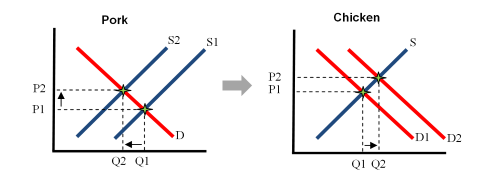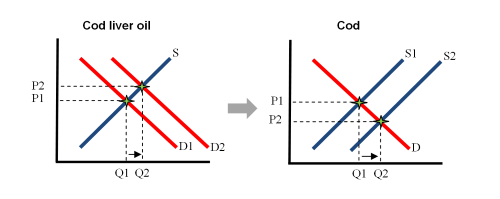This article describes and visualized interrelationships between markets. It defines joint demand, competitive demand, derived demand and joint supply.
After reading this story, you will be able to draw neat and accurate Price / Quantity diagrams to illustrate the interrelationships between markets as well as identify these concepts using real world examples.
Interrelationships between markets
Markets are not completely independent of each other. A change in one market, either demand or supply, may have great consequences on another. This is known as an interrelationship.
The various interrelationships between markets are detailed below.
1. Joint Demand
Complementary goods are those which consumers buy and use together. The markets for these goods are said to be in joint demand.
A. An increase in quantity demanded in one market can increase demand in the other.
B. A decrease in quantity demanded in one market can decrease demand in the other.
For example, a printer is a complementary good for a computer.

In the example above, the demand for computers increased (shifted outward to the right) because consumer income has risen. This result in consumers wishing to purchase more printers, the demand for printers increased resulting in an outward shift to the right in the printer market.
This quantity change is seen as the movement from Q1 to Q2.
2. Competitive Demand
Substitute goods are those which provide the same benefits as each other. The markets for these goods are said to be in competitive demand.
A. An increase in price in one market can increase quantity demanded in the other.
B. A decrease in price in one market can decrease quantity demanded in the other.
For example, pork and chicken as people eat once instead of another.

In the example above, the cost of feeding pigs has increased. Therefore the supply of pork has decreased because farmers are less willing and able to sell pork. This results in consumers wishing to purchase more chicken because the price of pork is more than before.
This quantity change is seen as the movement from Q1 to Q2.
3. Derived Demand
Derived demand occurs when the demand for a good exists because it is needed in the production of another.
A. If the quantity demanded in the consumer market increases, then firms must purchase more raw materials to meet higher demand.
B. If the quantity demanded in the consumer market decreases, then firms must purchase less raw materials to meet lower demand.
For example, demand for silk is derived from the demand for silk clothes. The same can be said for many other raw materials used in the production process such as gold, silver, platinum, lithium, steel, wood, diamonds, etc.

In the example above, the demand for silk clothes has increased because they have become more fashionable. The resulting movement along the supply means that firms are willing and able to produce more silk clothes. In order to do this, firms must purchase more silk, causing the outward shift in demand seen in the market for silk.
This quantity change is seen as the movement from Q1 to Q2.
4. Joint Supply
Some raw materials can be used to produce more than one product at the same time.
A. An increase in quantity supplied in one market can increase supply in the other.
B. A decrease in quantity supplied in one market can decrease supply in the other.
For example, cod (a type of fish) provides food and medicine at the same time. The flesh of the fish (cod) can be eaten, whilst the liver can produce cod liver oil that can be used for health and medical purposes.

In the example above, a more health conscious society has seen the demand for cod liver oil increase. This means the market for cod has seen a supply shift to the right as the liver oil is the only part of the fish required in the original market.
This supply change is seen as the movement from Q1 to Q2.
In summary, when markets change and it has an effect on another market, it is referred to as interrelationships between markets. There are several types interrelationships including joint demand, competitive demand, derived demand and joint supply.
 Articles: 1,677 · Readers: 768,000 · Views: 2,284,327
Articles: 1,677 · Readers: 768,000 · Views: 2,284,327 